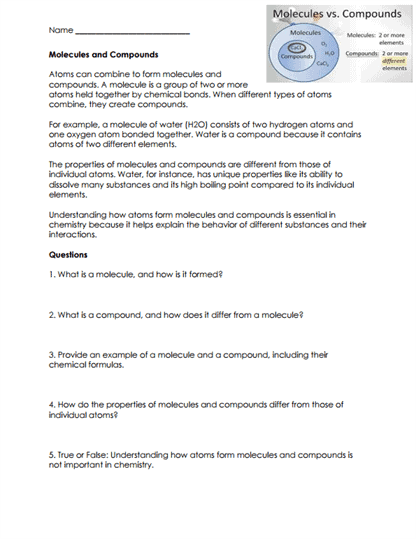Molecules and Compounds

Worksheet Description
The worksheet goes well into the foundational concepts of chemistry, discussing how individual atoms coalesce to form molecules and compounds. It demarcates the difference between a molecule, described as a group of two or more atoms linked by chemical bonds, and a compound, which arises when diverse types of atoms conjoin. By employing the instance of water (H2O) as an illustrative example, it elucidates that water is a compound created from the union of hydrogen and oxygen atoms. Additionally, it highlights the distinct properties that molecules and compounds manifest, which set them apart from singular atoms.
To adeptly understand and differentiate between molecules and compounds, one starts by familiarizing themselves with the basic constituents: atoms. Once the behavior of atoms is grasped, particularly their proclivity to bond through either electron sharing or transfer, the process of molecule formation becomes clearer. It’s crucial to observe and decode patterns in chemical formulas, as this aids in distinguishing molecules from compounds, the latter always comprising varied types of atoms. A more profound comprehension emerges by scrutinizing chemical reactions, revealing the unique behaviors and properties of both molecules and compounds in relation to lone atoms.
This educational tool aims to enlighten students on the nuances between molecules and compounds, stressing the importance of understanding their formation and distinguishing features. By posing questions and providing exemplifications, it encourages learners to probe deeper into the inherent properties that these entities exhibit in comparison to individual atoms. The overarching goal is to emphasize the pivotal role of molecules and compounds in the realm of chemistry, and their consequential interactions in a myriad of chemical processes. Through this exploration, students will gain a more holistic view of the microscopic interactions that underpin the macroscopic world.
